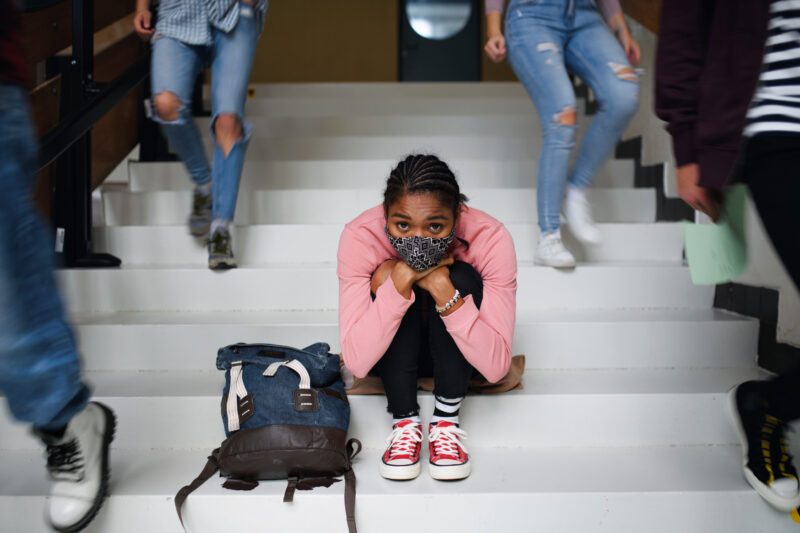5 Helpful Strategies To Cope With Back-To-School Anxiety
Back-to-school season is upon us. For students it is the end of summer break and the start of a new beginning. Administrators and counselors can help students and parents navigate this crucial time by being aware of common mental health issues that may arise and sharing these tips with parents.
Back-To-School Stress and Anxiety
Back-to-school can be a fun and exciting time for some students, but for others it can be a stressful time full of worry and anxiety. Some of these worries and anxieties may be due to normal stressors like going to a new school or making new friends. In the same fashion, abnormal stressors such as the fear of gun violence or getting sick from COVID is a reality that many students are currently facing.
According to the CDC, approximately 5.8 million children between the ages of 3-17 were diagnosed with anxiety between 2016 and 2019. Incredibly, these numbers do not reflect the damage done by the pandemic and other factors which continue to increase anxiety in kids. Today, we’re sharing a few coping skills and techniques to help students deal with these stressors related to back-to-school. Helping parents and students understand the many factors and how to deal with them can help everyone have a more enjoyable school year.
Normal Stressors and Anxieties
As mentioned above, some normal stressors you should let your parents know about include making new friends and going to a new school. Nevertheless, these are not the only normal stressors that can cause a student to feel anxious. Others include:
- Transition year - Moving from elementary school to middle school or middle school to high school
- Meeting their new teachers
- Academic performance pressures
- Dealing with bullying
- Concerns with relationships
See our online mental health curriculum to see how BASE Education can help students.
Abnormal Stressors and Anxieties
In addition, parents should also know that students nowadays have to deal with much more than what’s “normal”. For example, during the pandemic schools were required to drastically change their operations.This change caused some students’ mental health to worsen and anxiety continues to escalate. Below are a few other abnormal stressors students also face:
- Separation anxiety brought on by staying home during the start of the pandemic
- Social anxieties caused by isolation
- Health related anxieties caused by the fear of getting sick or getting their family members sick
- School shootings
Signs To Look Out For
Whether the stressors are normal or abnormal, they can cause anxiety in children that manifest in different ways. Naturally, these symptoms can show up both at home or at school. Some signs to look out for are:
- Mood swings, irritability, and excessive crying
- Headaches and stomach aches
- Changes in sleeping patterns
- Changes in eating patterns
- Excessive questioning or complete avoidance of back-to-school topic
- Lack of motivation in doing things they usually enjoy doing
These symptoms can vary depending on the student.
Strategies To Cope With Anxiety
Once the signs for anxiety and stress have been identified, knowing what to do next is crucial in providing students the support they need. Here are some strategies you can share with parents to help students cope with anxiety.
First, show the student support.
Be sure to have good communication with them to understand what is causing them to feel anxious. Empathize with their feelings and offer them an opportunity to express their emotions.
Second, be positive!
Speak to parents and let them know that their fears and insecurities can be projected onto their children. Be sure to remind them about all the positive things school has to offer and guide, both parent and student, into thinking differently.
Third, listen to them.
Do not dismiss the student's concern once they have opened up to you. For example, if they tell you their head or stomach is hurting, do not disregard it as an excuse or normal. Instead, encourage parents to offer their ears and listen to how the child is feeling.
Fourth, remind kids that they are not alone.
Remind them that it is okay to feel nervous, especially with so many changes happening at the same time. For that reason, they are not the only ones feeling this way.
And lastly, address their physical concerns.
If a student appears sleepier than usual, is losing weight or gaining weight too rapidly, start a conversation at home. Parents should establish a good sleeping schedule before school starts. Also, set up a healthy eating routine to help with their mood. If possible, and if the student is up for it, they can be enrolled in sport activities. Other students might thrive doing other activities such as journaling, painting, or reading books. These habits can help the body burn stress and ultimately help the student feel better.
It is also important to detect when the student or child needs to see a professional. If there is no progress, or there is a worsening in their symptoms, seeking help is advised. If a student needs additional help, contact the Substance Abuse and Mental Health Services Administration (SAMHSA) National Helpline at 1-800-662-4357.
Final Message From BASE Education
As a mental health solution for students, BASE Education knows the importance of providing an outlet for students to express themselves. We do this through journalistic introspection, self-reflection, and mindfulness allowing supervising adults to monitor feedback written by a more engaged student. With over 100 different mental health modules for K-12 students - including anxiety, depression, and worries - Counselors and administrators can provide an important tool to help students cope with these pressing issues.
In the end, informing parents about the different reasons a student might be anxious, stressed, or depressed during this back-to-school season and identifying the different symptoms is paramount. What follows is taking the right action and assisting the student so they can have a great school year.



